Program Case Study
Innovations in Creating Responsive Native Plant Markets: A Community-Supported Model
Lessons from the Natural Neighbors-Polly Hill Arboretum Partnership
By Tripti Thomas-Travers, October 2023.
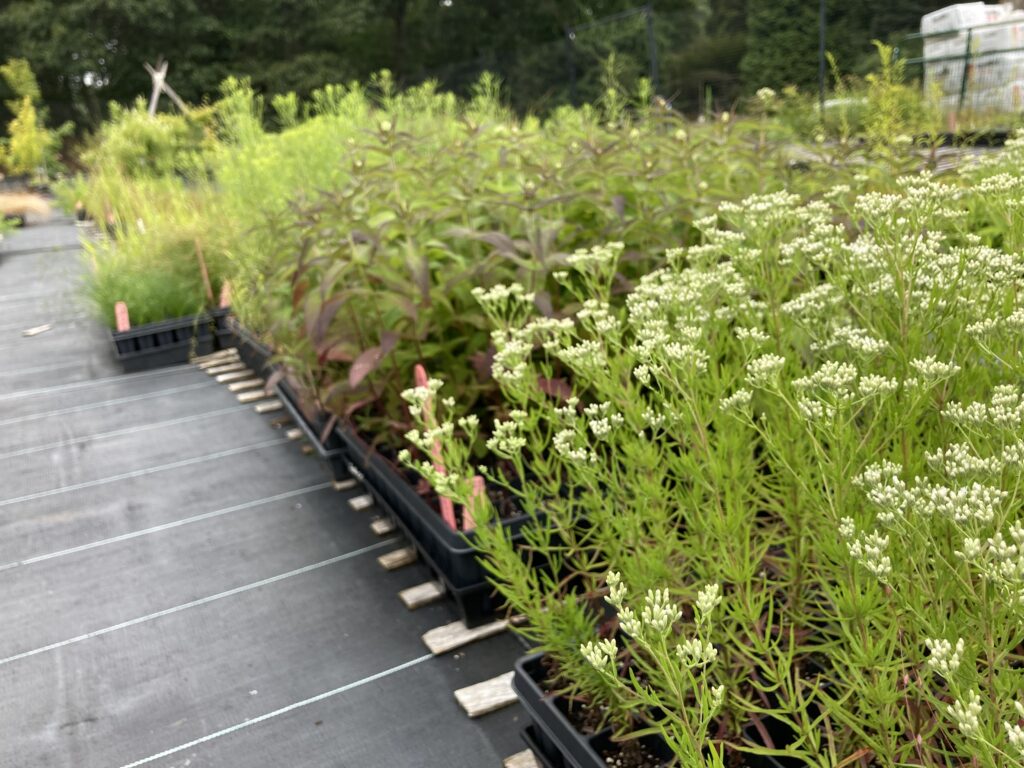
Summary
Native plants are the building blocks of microhabitat programs. However, reliable access to native plants, particularly of local genotype, can be challenging. At base, supply and demand are often not aligned, and do not always encompass what is needed to restore biodiversity in its many forms. This may be particularly true in small and isolated communities where the cultivation of plants of local genotype by commercial entities is not commercially viable.
Here we explore an innovative solution devised by Natural Neighbors, a microhabitat program of Martha’s Vineyard-based BiodiversityWorks, in partnership with Polly Hill Arboretum, a local nonprofit, to solve this problem.
Drawing on the Community Supported Agriculture model, this initiative offers Natural Neighbors participants access to plant packs, at cost, to suit specific yard conditions that are determined during site visits. Program participants purchase shares of the plant packs ahead of the season. While the sale price of plants is subsidized, the model is finding important ancillary benefits: It is mitigating risks for the plant producer, offering more inclusive access to the program and plants, driving popularity of the program and support to both organizations, and increasing the diversity of plants that are being introduced into yards.
Perfect Plants, Imperfect Markets
Native plants are the building blocks of efforts to re-naturalize yards and other microhabitats. But creating a responsive native plant market—where demand and supply are in sync—can be tricky. Among several factors, the supply and predictability of native plants is complicated by nature. Native plants are, ideally, grown from seed, instead of propagated vegetatively, to promote genetic diversity. But the availability of viable native plant seeds varies by year and the complexity of successful cultivation varies by species. This makes native plants more difficult to bring to market in a predictable way year after year. Many conventional nurseries do not carry native plants at all, let alone seed-grown plants of local genotype. Some nurseries may have experimented with native plants at a time when they were less popular, and found the demand insufficient to justify the costs of cultivation. Specialized native plant nurseries on the other hand may be few and far between and also face the issues of costly and unpredictable cultivation. Thus, community members excited about installing backyard habitats may not find the plants they are looking for at all, in convenient locations, or in the numbers, quantities and sizes that they aimed to purchase.
Moreover, nurseries may, understandably, focus on cultivating the plants that are most in demand, by consumers who themselves do not understand that this is only a small fraction of what needs to be reintroduced ecologically. All in all, supply and demand of native plants are often not aligned, and, also, often do not match the variety needed to restore biodiversity.
An Innovative Partnership
Martha’s Vineyard-based organizations BiodiversityWorks and Polly Hill Arboretum in Massachusetts have embarked on a partnership to solve this problem for their island community and for Natural Neighbors, a microhabitat program of BiodiversityWorks. They are using an innovative approach that draws on the Community Supported Agriculture (CSA) model. We decided to explore this approach recently, interviewing Rich Couse, Program Director of Natural Neighbors; Luanne Johnson, Director of BiodiversityWorks; and from Polly Hill Arboretum—Tim Boland and Emily Ellingson, Executive Director and Curator/Assistant Director, respectively. (Full disclosure, Village and Wilderness Executive Director, Tom Chase, works integrally with Natural Neighbors and was involved in this initiative.)
First, a little about each of the key entities.
Natural Neighbors was launched by the Vineyard-based conservation organization BiodiversityWorks in 2021. The program works with property owners and neighborhood associations, providing customized recommendations on management to promote wildlife and plant diversity, plant selection and ongoing stewardship to restore ecosystem function to yards and shared spaces. The planting areas slated for re-naturalization are usually under one acre, but can be larger in some cases. Natural Neighbors has tackled 222 yards to date and that number continues to grow.
Polly Hill Arboretum is the legacy of horticulturist Polly Hill, who planted the seeds of her vision in 1958. Today, the Arboretum is a non-profit organization focused on plant conservation, education and the preservation of its historic landscape and buildings. Currently, the property has 32 acres under cultivation and 40 acres of intact native woodland.
The Vineyard itself is a 96-square-mile island in the Atlantic Ocean, off the coast of Massachusetts. A popular summer destination, the island’s year-round population of around 17,000 expands to over 200,000 seasonal residents in the summer months. 56% of homes are seasonally occupied. The local population has also been growing since the 1970s, with an influx of wealthier new residents resulting in steady gentrification. There is a pronounced income gap between the summer and newer residents and the year-round, long-term residents. As underscored by a 2013 article in the Washington Post, “The average wage on Martha’s Vineyard is 71 percent of the state average, according to a recent government report on the island’s housing needs. By contrast, rental prices are 17 percent higher and house prices are 54 percent above average.” Many locals are deeply dependent upon the tourism economy and trades, while also having pressing competing concerns about affordable housing for themselves and their children, and for the island’s environment.
There is much greater income and ethnic diversity in the resident island population than popular perception would suggest. Economic justice communities including native tribes are particularly affected by low wages and the high cost of housing and living, which jeopardize their ability to persist as multi-generational members of the community, let alone be vested long-term in the ecosystem.
Organizations like BiodiversityWorks and Polly Hill Arboretum, are dedicated to preserving the fragile island ecology in the midst of these pressures.
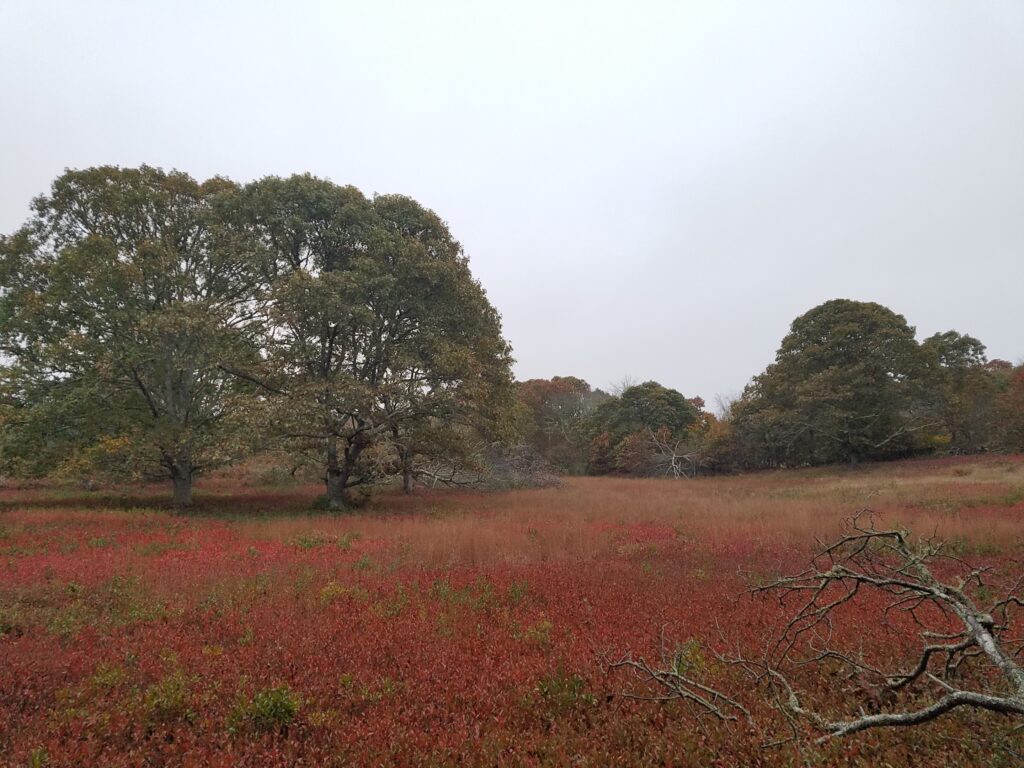
Applying the CSA Model to Native Plants: The Nuts and Bolts
When BiodiversityWorks initiated Natural Neighbors, they knew that visiting yards and recommending native plants would be fundamental features of the program. They approached Polly Hill Arboretum at the outset to secure access to native plants. Approaching a local source for plants in this case was particularly important: On an island such as the Vineyard, native plant genotypes are likely highly localized, and not even plants from the adjacent mainland area of Cape Cod may suffice for re-naturalization efforts that protect that genetic diversity. The Arboretum had been cultivating native plants from locally-collected seed since 2006, primarily for organizations conducting local restoration work. While not a commercial nursery, the Arboretum has held a “virtual plug sale” established in 2020, inviting the public to purchase native plant plugs online, with orders being picked-up onsite by customers at designated times. The demand for these offerings did not match plant supply—overproduction of plants was an issue.
A native plant market based on the CSA model had the potential to solve some of the mutual needs of both organizations. But first, what is Community Supported Agriculture? According to the US Departments of Agriculture’s National Agricultural Library, CSA is “one type of direct marketing, [that] consists of a community of individuals who pledge support to a farm operation so that the farmland becomes, either legally or spiritually, the community’s farm, with the growers and consumers providing mutual support and sharing the risks and benefits of food production.”
Among other nuances of this model, consumers make cash commitments in advance of the growing season, and are periodically supplied with a commensurate share of whatever the farm harvests that year. Consumers benefit from a healthy variety of locally-grown, seasonal produce, and the farm benefits from being able to manage its upfront costs and production risks more sustainably. Analogously, in the CSA for native plants, the consumer receives a variety of local genotype plants, and the nursery is better able to manage its costs and risks.
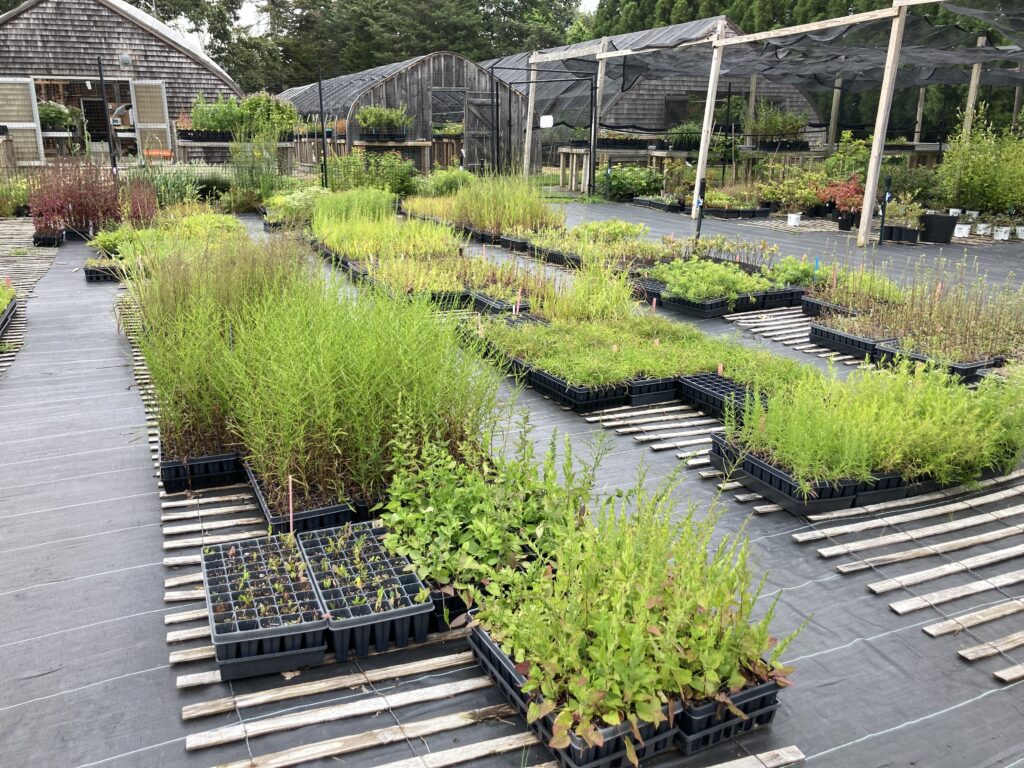
Since the launch of Natural Neighbors in May 2021, implementation of the partnership has been evolving. Initially, Natural Neighbors referred people to the Arboretum’s virtual plug sale. Starting in August 2021, Natural Neighbors offered its first native plant sale in partnership with the Arboretum. Each pack for sale had 5 plugs of 5 species—25 total for pickup in September. People placed their order using this Google form. In Spring 2022, Natural Neighbors moved to a more CSA-style model, where participants ordered and pre-paid for plug-packs either as a full share—spring and fall, or as a half share (just spring or fall). The packs had 20 plugs, each with 5 plugs of 4 species, with some accommodation for the variability in supply. The Google order form for this sale is illustrative.
In 2023, Natural Neighbors has continued with the CSA pre-pay-for-shares model, but further refined it by offering plant packs differentiated for the customer primarily by growing conditions (not by species), and using a payment model integrated with the BiodiversityWorks website. This is how those packs have come together: Natural Neighbors worked with the Arboretum early in the growing season to get a sense of what had been newly cultivated, what had overwintered successfully, and what would be ready for a sale as plugs by springtime. Thus informed, Natural Neighbors curated four plant packs, one for each of the following site conditions: sunny-dry-soil, shady-dry-soil, shady-wet-soil, and—given growing interest in rewilding lawns—a meadow pack. Each pack was designed to comprise 25 plants, 5 each of 5 different species.
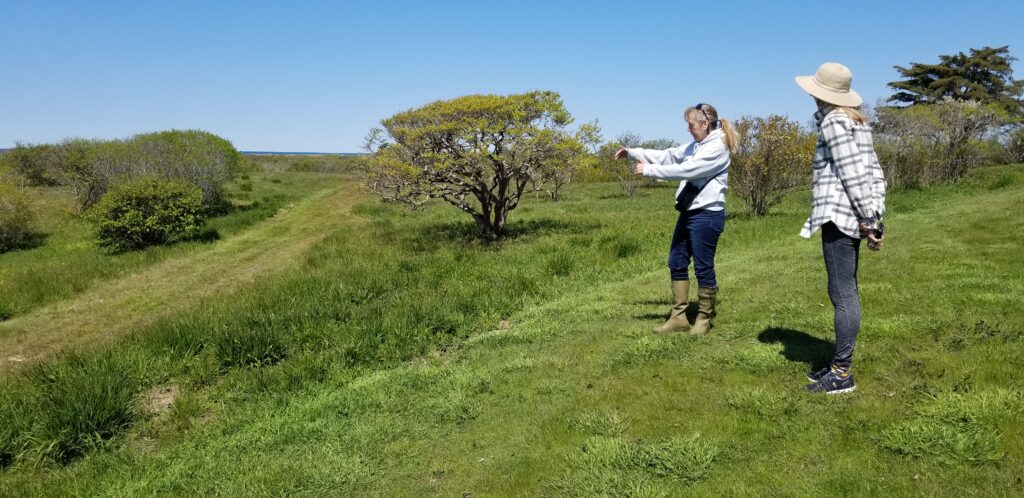
When Natural Neighbors staff visited program sites, they assessed the site conditions and drew-up a site-specific report, identifying whether and where these four soil and sun conditions were prevalent on the site (See sample sites reports 1 and 2). Participants were then invited to go online during the sale window to pre-order and pre-pay for the appropriate packs in the numbers that they needed for their yards. The packs were sold by BiodiversityWorks via email communications with the Natural Neighbors community. The plant packs were only sold through and to the Natural Neighbors community in an effort to ensure they would be planted in the appropriate areas. The pre-orders determined how many plants Natural Neighbors picked up from the Arboretum in spring, and assembled into packs with staff and volunteers for customers to pick up over a three-day period. This process is repeating itself for the fall planting season.
It has been a year-and-a-half since the two partners embarked on a version of the CSA model, conducting two spring sales and one fall sale as of this writing. While it is still early days, what has been the experience thus far?
For Polly Hill Arboretum, the staff note three main benefits:
More Predictable Demand: Says Boland, “This model has given us more consistency in terms of demand, whereas before, we were just overproducing native plants and trying to get people to use them, which was difficult.”
Increasing sales: “More packs were ordered this year than the last. The first year we sold 780 plugs in the spring, this year it was 1000,” says Ellingson, noting that this sale has done better than the virtual plug sale to the general public. “The process of having staff from Natural Neighbors visit and teach people what they can do to enhance their yards, increases demand by increasing awareness and confidence. I think that is the biggest thing, because people don’t always know how they could be really used in the landscape. This is where Natural Neighbors comes in.”
Increased Diversity of Plant Purchases: Ellingson estimates that in the first spring, the Arboretum sold about 11 different plant species in spring, and 8-to-9 species in the fall. However this past spring alone they have been able to increase the number of species to 17, because of the increased diversity that could be included in the assortments organized by growing conditions. Says Ellingson to her Natural Neighbors counterparts, “It’s pretty cool to see the diversity of plants that you all put out into the yards. We’d like to try to increase that over time.” She notes that an essential aspect of increasing the diversity of plant supply and demand over the long term, will lie in figuring out what plants actually succeed in yards. This, she believes, is part of an ongoing conversation and feedback loop that Natural Neighbors will help facilitate.
From the Arboretum’s perspective, they attribute the overall uptick in these metrics to the intermediary role that Natural Neighbors plays with program participants. Underscores Boland, “I always say it is all about the art and science of it. People know the science—they know that these plants are really valuable ecologically, but it is the artistic part that they worry about. It can be kind of overwhelming. They sometimes lack confidence, and may just need a nudge. And I think Natural Neighbors does that given their assistance with design, selection and placement.”
As for Natural Neighbors, this model is helping them achieve their mission of restoring ecosystem function in the yards of increasing numbers of community members, a mission that is underpinned by the availability of site-appropriate native plants. As Couse notes, “One of the biggest questions I get from people is, ‘Where can I get native plants on the island?’” This endeavor with Polly Hill Arboretum helps the program answer that question with confidence.
Couse and Johnson predict that they will continue to offer spring and fall plant packs for the foreseeable future, based on the success of the experiment so far. They anticipate that interest in re-naturalizing yards will continue as awareness grows in the community, bringing new program participants, and thus continued demand for native plants. Furthermore, observes Couse, growth in demand will also come from existing participants: “There are people who are interested in adding to what they have already grown, because they now have their own little restoration projects that they are working on.” From an ecosystem standpoint, this observation underscores another benefit of the community-supported model: the potential to expand plant diversity with every additional year that yard owners participate in the program.
Some Logistical Considerations
While the intended outcomes have been achieved, implementation has imposed some logistics that are familiar to a commercial enterprise. Here are some of some important considerations that both parties underscored for non-commercial entities contemplating creating a similar system:
1. Consider the cost and complexity of facilitating sales transactions: Both Couse and Johnson underline that setting up a point of sale system is a lot of work. As Johnson notes, “We created curated plant packs for the Natural Neighbors community, and told people, ‘Here they are! You can order them!’ However, not being a commercial nursery, nor being an organization that facilitates sales, we actually had to create a sales platform and set the items up for sale. This was a huge learning curve.”
The first time implementing the pre-pay model, Natural Neighbors had to re-create invoices in Paypal for customers, who had placed their orders through the Google form. The payments then had to be re-entered into the organization’s Quickbooks accounting system, a double-entry process that was extremely time consuming. They knew they had to find a different approach the next time, and set up a point of sale through WooCommerce and WordPress (their website platform), with Stripe as the payment platform. They now have a tested system in place. But Johnson is realistic: “Now we have a system and we know how to do it, but each time we do a sale, we are going to have to create the items anew, because in the next season, maybe we’re going to sell something different and the packs are going to look different. It’ll be an easier process because we’ve done it before, but for people looking to start this up, they just need to think about how they’re going to sell. What’s that going to look like?”
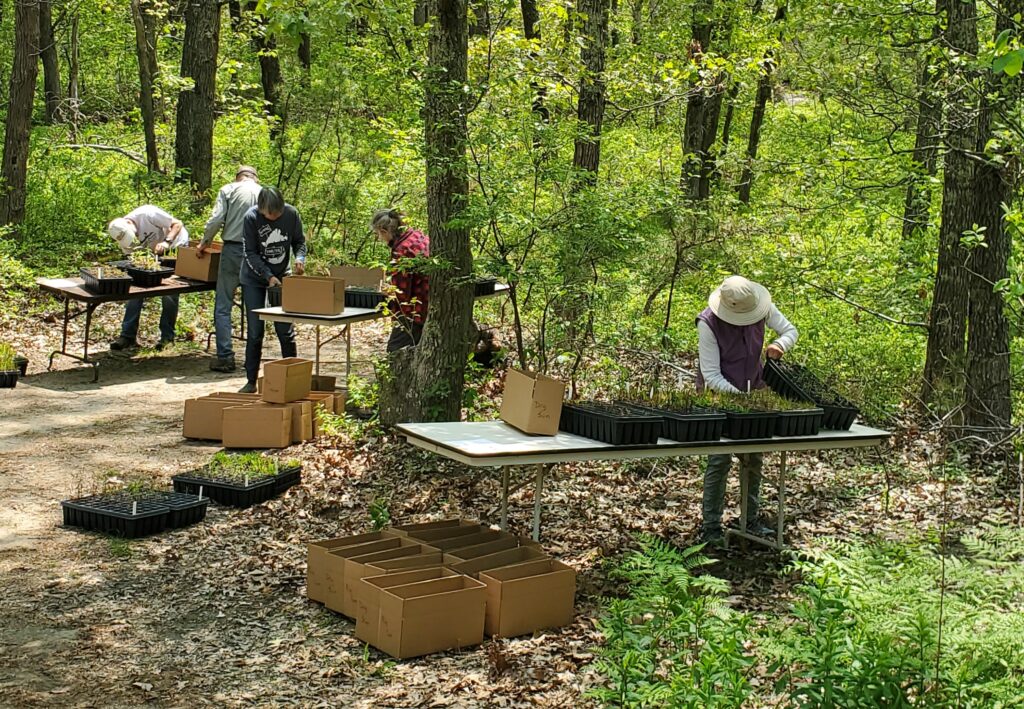
2. Consider that the sale price may not reflect cost: Both organizations are committed to keeping the cost of the plants as affordable as possible for program participants, given that the island has a low wage standard and very high cost of living, particularly for economic justice communities. Keeping plants affordable is an important, socially-conscious element of the Natural Neighbors program. However, the entire process from seed-to-sale is a time- and labor-intensive process for both parties, and far from a profit-making proposition. In fact both organizations estimate that they subsidize this effort substantially. This subsidy, however, is off-set by the donations in support of their overall programs.
For the Arboretum the bulk of its effort lies in seed collection and cultivation. Seeds must be collected at the right time, stored with or without stratification, germinated in the right quantities, transplanted, watered (even on weekends), overwintered, etc., to mention just a few steps. There are also other factors such as the recent shortage and rising costs of materials including trays and soil. A large volunteer effort for seed collection, and the recent installation of a timed irrigation system, mitigates some of the associated costs. The costs are not always reflected in the price at which they sell the plants, as they understand the price-sensitivity in the community.
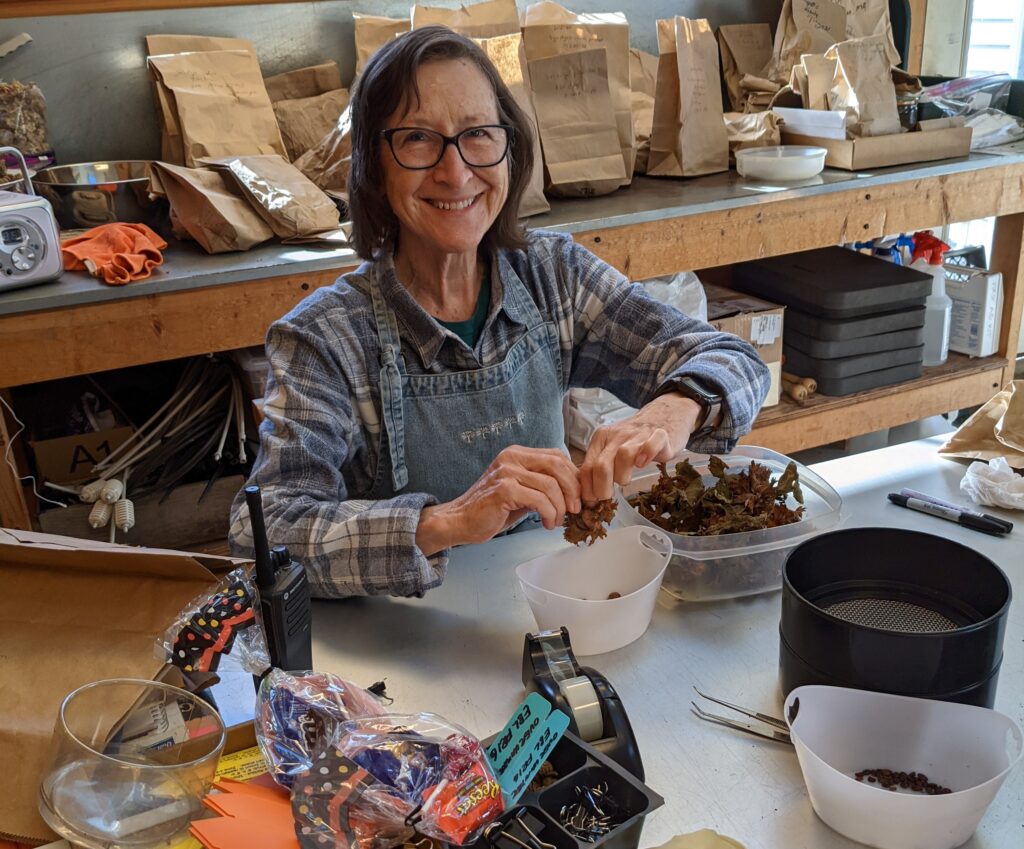
For Natural Neighbors, which selects the species in the packs in collaboration with Polly Hill Staff, then assembles and sells the plant packs, the actual costs are not recouped from the plant sales as the plants are sold at the Arboretum’s price without any further markup. Inputs subsidized by the organization include staff and contractor time for setting up the point of sale and integrating the transactions into the accounting system. Another subsidized input is staff time for designing and assembling 40 plant packs of a thousand or more plants, albeit with the help of a half-dozen volunteers.
But solutions for mitigating costs are being considered. One option for Natural Neighbors, for instance, may be to post both the sale price and the real cost of bringing the products to market on the retail site, so that people can choose what they are able and willing to pay. This may encourage more affluent participants to voluntarily pay the higher price. Another option is to invite people to donate money toward the administrative costs. Whatever the steps used, they must comply with tax rules relevant to sales conducted by non-profits. Currently, the true cost is paid for by the general support for the Natural Neighbors program, as part of BiodiversityWorks. Reflecting on the whole process, Johnson says: “It’s complicated. Not being a commercial enterprise, a nonprofit that is going to undertake this should know that there is a lot to learn and prepare for.”
Achieving the Mission, Plant-Pack By Pack
At the end of the day, both organizations emphatically believe that providing these plants conveniently and affordably helps them achieve their individual missions and goals.
For the Arboretum, says Boland, “It’s just a feel good thing for our membership. And I think that carries a lot of weight. People are very supportive and we have gotten really good feedback. They think it is cool that an arboretum is doing this, even though we are not, for example, the Native Plant Trust, and do not have the facilities to grow a lot. But it is just the kind of niche in which the homeowner can get really involved. We would also really like to get younger people, the next generation, involved and invested, and this is one way we can do that.” Furthermore, they see the potential of this partnership and model long-term. Attests Ellingson, “Natural Neighbors is helping people understand their yards and what they can plant in them, enabling them to purchase plants that can be used. I see this as the sticking point of normalizing native plants in everyone’s landscape—it’s like the next step.” The Arboretum’s expanded vision going forward includes a recently-hired plant-propagator, and growing more native trees and shrubs in addition to the herbaceous perennials.
Speaking for Natural Neighbors, Johnson says “The most important thing for us is that selling these native plant packs through the Natural Neighbors program is very successful in doing what it has been designed to do: It’s getting native plants out there into yards and getting people talking about buying natives. Everybody who comes to pick up their plants is very excited to get them in the ground.They are sending us pictures of their plants and sharing them with the community on the Natural Neighbors Facebook page.” Couse also notes that as participants are getting more educated, they are starting to ask about categories of plants beyond perennials, such as shrubs and tree saplings.
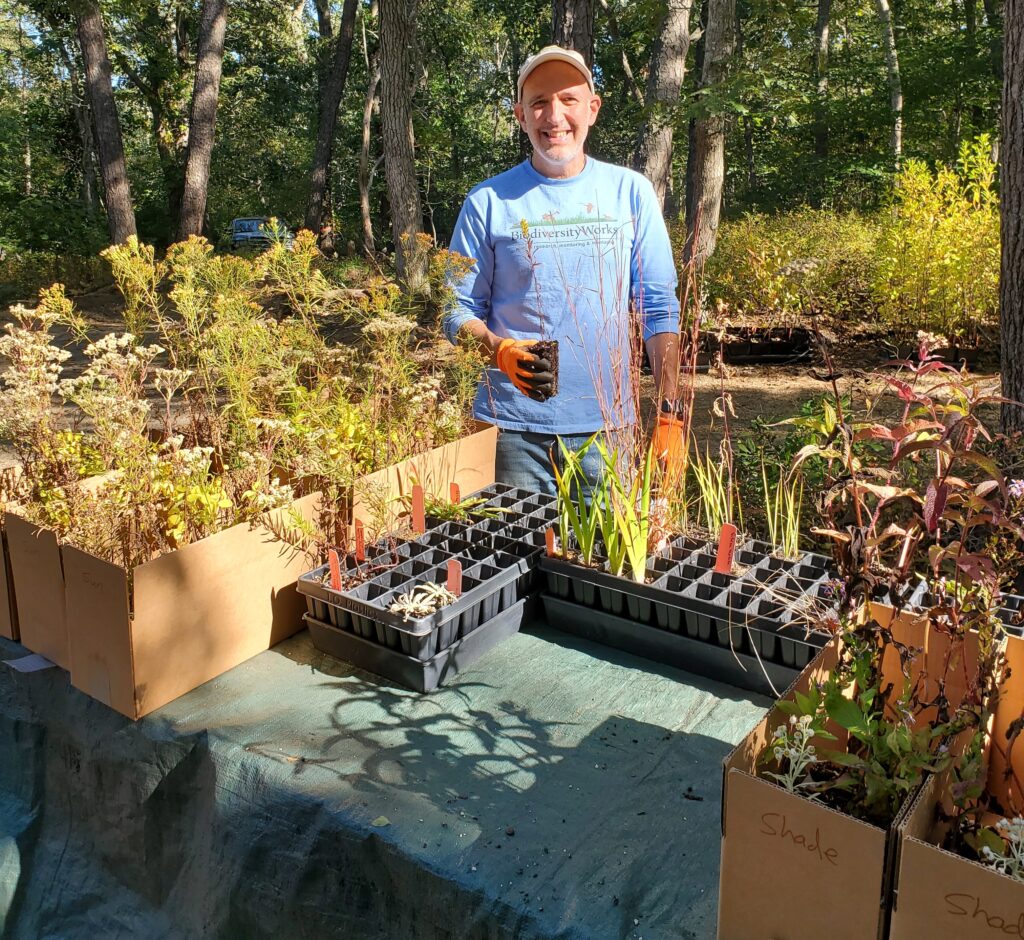
Conclusion
At base, the model has the potential to fix some of the inherent mismatch in demand and supply in native plant markets, benefitting both the microhabitat program and the plant cultivator/seller. But there are also some other areas in which it can amplify the work of both entities and help them realize their mission:
1. Biodiversity: With the focus on plant-packs based on growing-conditions instead of individual species, the community-supported model allows microhabitat programs and plant suppliers to introduce a more diverse variety of plants to program participants than they may otherwise be willing to try. It is, if you will, an educational, Trojan Horse approach to restoring biodiversity in yards. And the longer a yard participates, the more plant biodiversity can be introduced, tried, tested and learned about by all parties. This also offsets the problem that not every plant species sets seed reliably every year. The community-supported model turns that disadvantage into an ecological advantage.
2. Accessibility: The community-supported model may be particularly beneficial in small and isolated communities, where local genotypes are important and where commercial growers are not available. The community-supported model makes it possible to partner with a non-commercial entity, which can produce ecologically appropriate plants while mitigating their production risks. In sum, it makes it possible for such communities to participate in microhabitat programs.
3. Funding and Equity: Access to affordable plants can make the microhabitat program popular and attract funding to the organization as a whole. Natural Neighbors, for instance, is an enormously popular program. As designed—including the access to affordable plants—it attracts people to the program, and fosters loyalty and donations to the organization as a whole. This in turn allows the program to provide plants at an affordable price and meet equity goals while also covering ground even in marginalized communities.
The community-supported model is a promising one for microhabitat programs and their native-plant-supply partners to consider. It is an especially interesting option for programs based in small, isolated communities where local genotype is important, and where large-scale commercial growers are not available or only interested in supplying a small variety of popular species. We look forward to keeping tabs on this experiment as it evolves and to sharing the lessons that Natural Neighbors and Polly Hill Arboretum learn with other microhabitat programs.
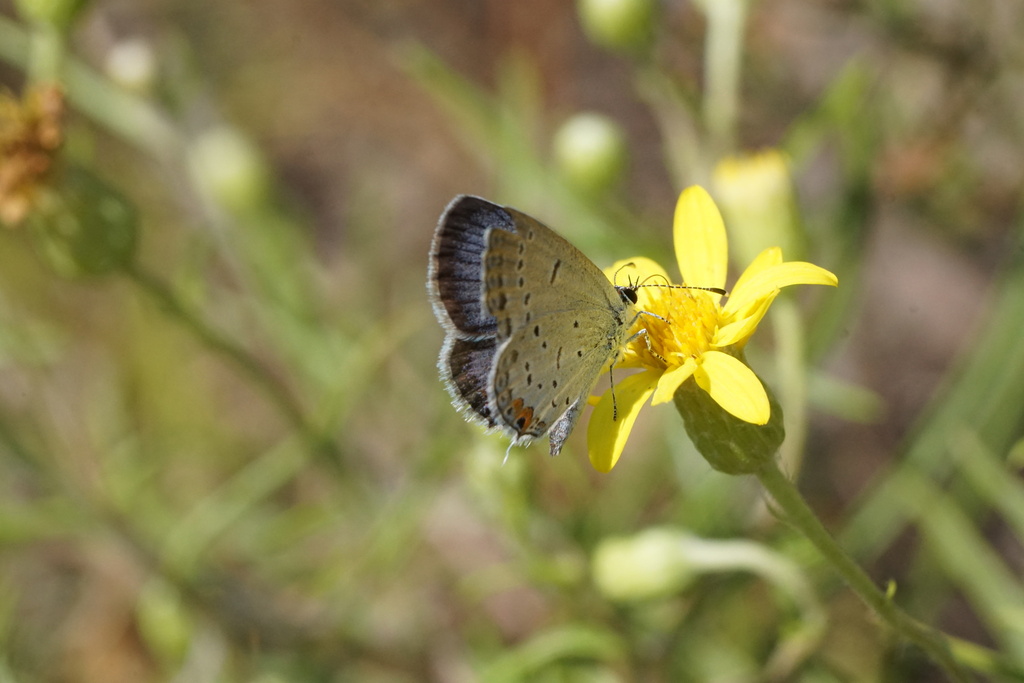
Village and Wilderness amplifies the work of community-based innovators by supporting efforts to discover, prove and share replicable climate adaption strategies. Our flagship project is the Microhabitat Program Incubator.
This case study is part of a series of written resource materials that Village and Wilderness is developing to share lessons and best-practices across existing and emerging microhabitat programs.
What is a Microhabitat Program?
Community-based programs designed to convert small patches of land into ecologically useful habitat are emerging everywhere. From rewilding private land, to establishing urban shade gardens, bioswales and pollinator-friendly roadside verges and farmland margins—restoring ecosystem function in the fragmented landscape is the common theme.
While “backyard habitat programs” is a term that has been commonly used to describe many of these efforts, we propose more encompassing terms—such as microhabitat programs. We believe that these programs are part of a broader movement comprising the universe of community-based and individual efforts and to restore ecosystem function and ecological productivity to the fragmented landscape.

